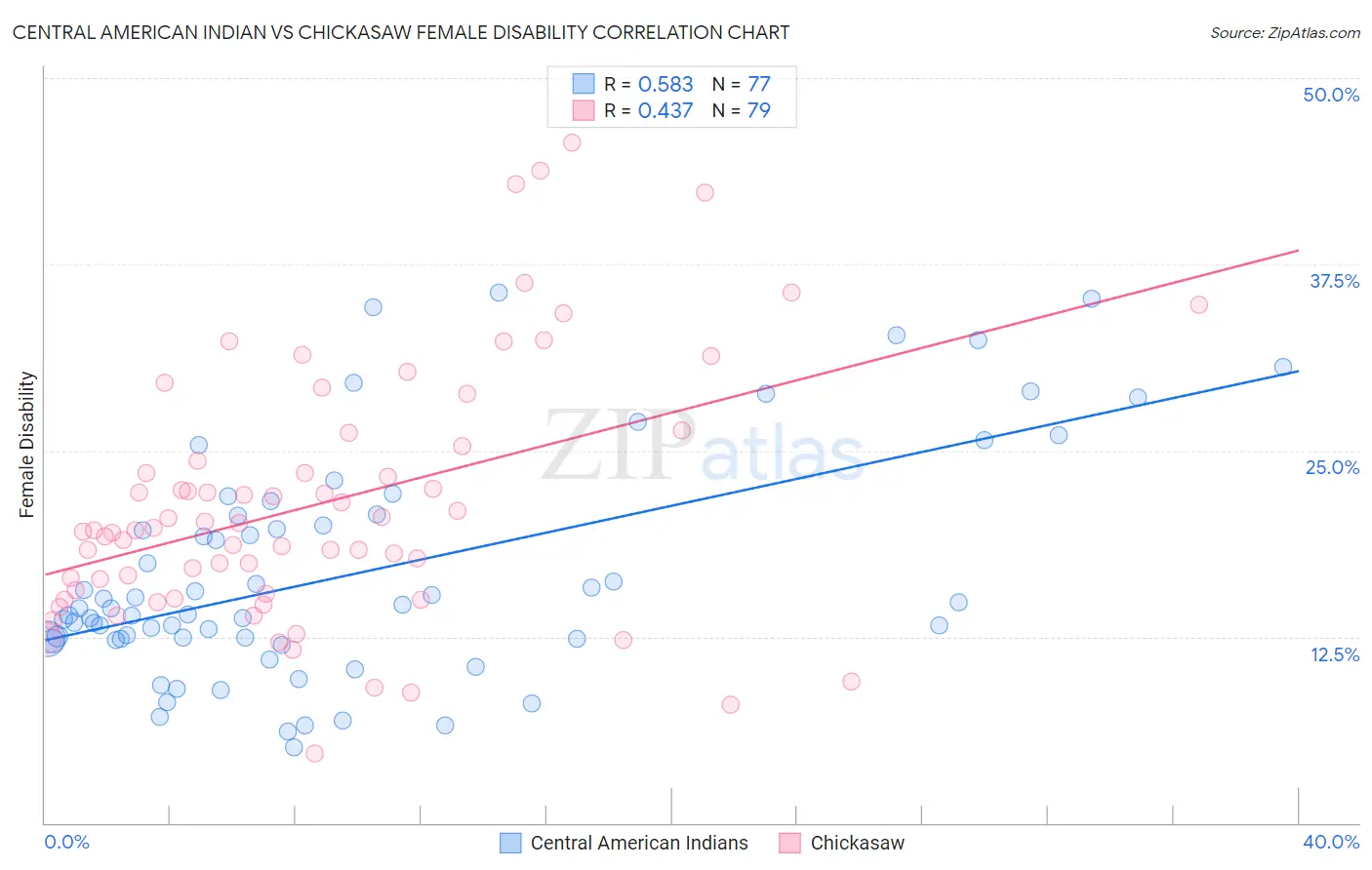Central American Indian vs Chickasaw Female Disability
COMPARE
Central American Indian
Chickasaw
Female Disability
Female Disability Comparison
Central American Indians
Chickasaw
13.6%
FEMALE DISABILITY
0.0/ 100
METRIC RATING
307th/ 347
METRIC RANK
15.2%
FEMALE DISABILITY
0.0/ 100
METRIC RATING
340th/ 347
METRIC RANK
Central American Indian vs Chickasaw Female Disability Correlation Chart
The statistical analysis conducted on geographies consisting of 326,112,462 people shows a substantial positive correlation between the proportion of Central American Indians and percentage of females with a disability in the United States with a correlation coefficient (R) of 0.583 and weighted average of 13.6%. Similarly, the statistical analysis conducted on geographies consisting of 147,688,443 people shows a moderate positive correlation between the proportion of Chickasaw and percentage of females with a disability in the United States with a correlation coefficient (R) of 0.437 and weighted average of 15.2%, a difference of 11.7%.

Female Disability Correlation Summary
| Measurement | Central American Indian | Chickasaw |
| Minimum | 5.1% | 4.7% |
| Maximum | 35.6% | 45.6% |
| Range | 30.5% | 41.0% |
| Mean | 16.8% | 21.5% |
| Median | 14.4% | 19.7% |
| Interquartile 25% (IQ1) | 12.3% | 15.4% |
| Interquartile 75% (IQ3) | 20.7% | 25.3% |
| Interquartile Range (IQR) | 8.3% | 9.8% |
| Standard Deviation (Sample) | 7.6% | 8.6% |
| Standard Deviation (Population) | 7.5% | 8.5% |
Similar Demographics by Female Disability
Demographics Similar to Central American Indians by Female Disability
In terms of female disability, the demographic groups most similar to Central American Indians are French Canadian (13.6%, a difference of 0.29%), Cree (13.7%, a difference of 0.46%), French American Indian (13.7%, a difference of 0.52%), Apache (13.7%, a difference of 0.63%), and Dominican (13.5%, a difference of 0.92%).
| Demographics | Rating | Rank | Female Disability |
| Pennsylvania Germans | 0.0 /100 | #300 | Tragic 13.4% |
| Africans | 0.0 /100 | #301 | Tragic 13.4% |
| Scotch-Irish | 0.0 /100 | #302 | Tragic 13.4% |
| Immigrants | Portugal | 0.0 /100 | #303 | Tragic 13.5% |
| Immigrants | Micronesia | 0.0 /100 | #304 | Tragic 13.5% |
| Dominicans | 0.0 /100 | #305 | Tragic 13.5% |
| French Canadians | 0.0 /100 | #306 | Tragic 13.6% |
| Central American Indians | 0.0 /100 | #307 | Tragic 13.6% |
| Cree | 0.0 /100 | #308 | Tragic 13.7% |
| French American Indians | 0.0 /100 | #309 | Tragic 13.7% |
| Apache | 0.0 /100 | #310 | Tragic 13.7% |
| Hopi | 0.0 /100 | #311 | Tragic 13.7% |
| Delaware | 0.0 /100 | #312 | Tragic 13.8% |
| Blackfeet | 0.0 /100 | #313 | Tragic 13.8% |
| Puget Sound Salish | 0.0 /100 | #314 | Tragic 13.8% |
Demographics Similar to Chickasaw by Female Disability
In terms of female disability, the demographic groups most similar to Chickasaw are Colville (15.1%, a difference of 0.95%), Dutch West Indian (15.0%, a difference of 1.4%), Choctaw (15.4%, a difference of 1.4%), Tohono O'odham (15.0%, a difference of 1.5%), and Seminole (15.0%, a difference of 1.6%).
| Demographics | Rating | Rank | Female Disability |
| Immigrants | Azores | 0.0 /100 | #333 | Tragic 14.9% |
| Cherokee | 0.0 /100 | #334 | Tragic 14.9% |
| Cajuns | 0.0 /100 | #335 | Tragic 14.9% |
| Seminole | 0.0 /100 | #336 | Tragic 15.0% |
| Tohono O'odham | 0.0 /100 | #337 | Tragic 15.0% |
| Dutch West Indians | 0.0 /100 | #338 | Tragic 15.0% |
| Colville | 0.0 /100 | #339 | Tragic 15.1% |
| Chickasaw | 0.0 /100 | #340 | Tragic 15.2% |
| Choctaw | 0.0 /100 | #341 | Tragic 15.4% |
| Creek | 0.0 /100 | #342 | Tragic 15.7% |
| Lumbee | 0.0 /100 | #343 | Tragic 15.8% |
| Kiowa | 0.0 /100 | #344 | Tragic 15.8% |
| Puerto Ricans | 0.0 /100 | #345 | Tragic 16.6% |
| Tsimshian | 0.0 /100 | #346 | Tragic 16.8% |
| Houma | 0.0 /100 | #347 | Tragic 16.9% |